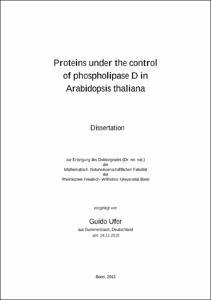Ufer, Guido: Proteins under the control of phospholipase D in Arabidopsis thaliana. - Bonn, 2016. - Dissertation, Rheinische Friedrich-Wilhelms-Universität Bonn.
Online-Ausgabe in bonndoc: https://nbn-resolving.org/urn:nbn:de:hbz:5n-43242
Online-Ausgabe in bonndoc: https://nbn-resolving.org/urn:nbn:de:hbz:5n-43242
@phdthesis{handle:20.500.11811/6743,
urn: https://nbn-resolving.org/urn:nbn:de:hbz:5n-43242,
author = {{Guido Ufer}},
title = {Proteins under the control of phospholipase D in Arabidopsis thaliana},
school = {Rheinische Friedrich-Wilhelms-Universität Bonn},
year = 2016,
month = may,
note = {The phosphoproteome of the pldα1-mutant lacks a protein that is abundantly expressed in the wild type and has been identified as the unknown protein At5g39570.1. The characterization of this protein in the context of PLD-regulatory networks was in the focus of this thesis.
In silico analysis revealed extraordinary features of At5g39570.1 which incorporates ten imperfect tandem repeats in its C-terminal end. Amino acid composition, hydrophobicity, secondary structure and blast analyses suggest a separation of the protein into a conserved N-terminal region and a more variable C-terminal protein half with unique properties. Orthologs of the protein At5g39570.1 were identified in nearly all plant families. The homologous protein At3g29075 shares high sequence similarities in the N-terminal protein half but no redundant function of both proteins has been identified by the generation and analysis of double knock-out/knock-down mutant plants.
At5g39570.1 was confirmed to be a downstream target of the PLD-regulated signaling network. It was demonstrated that the abundance of At5g39570.1 is dependent on different members of the PLD family whereat PLDα1 is the key regulator for its expression. Water-limiting conditions were shown to induce the expression of At5g39570.1 in the absence of PLDα1. A regulatory model for At5g39570.1 suggests a repressor that blocks the transcription of At5g39570.1 in the absence of PLDα1. Drought-induced accumulation of lipid-signaling molecules, such as PA may displace the repressor from the gene and enable protein production. While a direct interaction of PLDα1 and At5g39570.1 was not observed, an indirect interaction of both proteins via the second messenger PA has been demonstrated.
Wild-type and mutant plants were phenotypically monitored upon different abiotic stresses. Severe salinity triggered a necrotic phenotype similar to pldα1 mutants, while wild-type plants were only slightly impaired. Water-limiting conditions further led to an increased phosphorylation of At5g39570.1 in the wild type and propagated At5g39570.1 expression levels in pldα1 mutants, suggesting an involvement in the response to abiotic stress.
A yeast-two-hybrid assay identified potential interacting candidates that are involved in various RNA-associated processes. Repetitive identification of members of the MORF family suggests a function of At5g39570.1 in RNA-editing processes. Although these findings are supported by in silico analyses, additional protein-protein interaction methods have not yet confirmed any interacting partners. Further experiments are required to classify At5g39570.1 as a genuine protein involved in RNA-processing.},
url = {https://hdl.handle.net/20.500.11811/6743}
}
urn: https://nbn-resolving.org/urn:nbn:de:hbz:5n-43242,
author = {{Guido Ufer}},
title = {Proteins under the control of phospholipase D in Arabidopsis thaliana},
school = {Rheinische Friedrich-Wilhelms-Universität Bonn},
year = 2016,
month = may,
note = {The phosphoproteome of the pldα1-mutant lacks a protein that is abundantly expressed in the wild type and has been identified as the unknown protein At5g39570.1. The characterization of this protein in the context of PLD-regulatory networks was in the focus of this thesis.
In silico analysis revealed extraordinary features of At5g39570.1 which incorporates ten imperfect tandem repeats in its C-terminal end. Amino acid composition, hydrophobicity, secondary structure and blast analyses suggest a separation of the protein into a conserved N-terminal region and a more variable C-terminal protein half with unique properties. Orthologs of the protein At5g39570.1 were identified in nearly all plant families. The homologous protein At3g29075 shares high sequence similarities in the N-terminal protein half but no redundant function of both proteins has been identified by the generation and analysis of double knock-out/knock-down mutant plants.
At5g39570.1 was confirmed to be a downstream target of the PLD-regulated signaling network. It was demonstrated that the abundance of At5g39570.1 is dependent on different members of the PLD family whereat PLDα1 is the key regulator for its expression. Water-limiting conditions were shown to induce the expression of At5g39570.1 in the absence of PLDα1. A regulatory model for At5g39570.1 suggests a repressor that blocks the transcription of At5g39570.1 in the absence of PLDα1. Drought-induced accumulation of lipid-signaling molecules, such as PA may displace the repressor from the gene and enable protein production. While a direct interaction of PLDα1 and At5g39570.1 was not observed, an indirect interaction of both proteins via the second messenger PA has been demonstrated.
Wild-type and mutant plants were phenotypically monitored upon different abiotic stresses. Severe salinity triggered a necrotic phenotype similar to pldα1 mutants, while wild-type plants were only slightly impaired. Water-limiting conditions further led to an increased phosphorylation of At5g39570.1 in the wild type and propagated At5g39570.1 expression levels in pldα1 mutants, suggesting an involvement in the response to abiotic stress.
A yeast-two-hybrid assay identified potential interacting candidates that are involved in various RNA-associated processes. Repetitive identification of members of the MORF family suggests a function of At5g39570.1 in RNA-editing processes. Although these findings are supported by in silico analyses, additional protein-protein interaction methods have not yet confirmed any interacting partners. Further experiments are required to classify At5g39570.1 as a genuine protein involved in RNA-processing.},
url = {https://hdl.handle.net/20.500.11811/6743}
}






